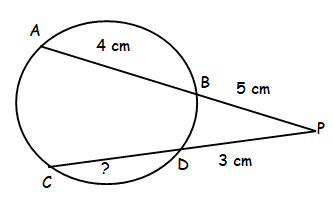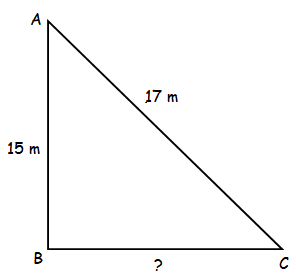GRADE 10 MATH PRACTICE QUESTIONS
Subscribe to our ▶️ YouTube channel 🔴 for the latest videos, updates, and tips.
Problem 1 :
AB and CD are two chords of a circle which intersect each other externally at P. If AB = 4 cm, BP = 5 cm, PD = 3 cm, then the length of CD is.
Solution :

PA ⋅ PB = PC ⋅ PD
Let x be CD.
PA = 9 cm, PB = 5 cm, PC = 3 + x and PD = 3 cm
9 ⋅ 5 = (3 + x) ⋅ 3
15 = 3 + x
x = 15 - 3
x = 12
So, CD is 12 cm.
Problem 2 :
Find a if the slope of the line joining (-6, 13) and (3, a) is -1/3
Solution :
Slope of the line = (y2 - y1)/(x2 - x1)
(a - 13) / (3 + 6) = -1/3
(a - 13) / 9 = -1/3
a - 13 = -3
a = -3 + 13
a = 10
So, the value of a is 10.
Problem 3 :
Two dice are thrown together. What is the probability of getting a total 8 or a product 12.
Solution :
Sample space =
{(1, 1) (1, 2) (1, 3) (1, 4) (1, 5) (1, 6) (2, 1) (2, 2) (2, 3) (2, 4) (2, 5) (2, 6) (3, 1) (3, 2) (3, 3) (3, 4) (3, 5) (3, 6) (4, 1) (4, 2) (4, 3) (4, 4) (4, 5) (4, 6) (5, 1) (5, 2) (5, 3) (5, 4) (5, 5) (5, 6) 6 (6, 1) (6, 2) (6, 3) (6, 4) (6, 5) (6, 6) }
n(s) = 36
Let A and B are the events of the sum 8 or the product is 12.
A = {(2, 6) (3, 5) (4, 4) (5, 3) (6, 2)}
n(A) = 5
p(A) = n(A)/n(S)
p(A) = 5/36
B = { (2, 6) (3, 4) (4, 3)(6, 2) }
n(B) = 4
p(B) = 4/36
A n B = {(2, 6) (6, 2)}
n(A n B) = 2
p(A n B) = n(A n B) / n(S)
p(A n B0 = 2/36
P(A u B) = p(A) + p(B) - p(A n B)
= 5/36 + 4/36 - 2/36
= (9 - 2)/36
= 7/36
So, the probability of getting the sum 8 or the product as 12 is 7/36.
Problem 4 :
The line joining the points (-2, 7) and (3, 6) is parallel to the line joining (4, a) and (9, 1), find a.
Solution :
If two lines are parallel, they will have equal slopes.
Let the given points as A(-2, 7), B(3, 6), C(4, a) and D(9, 1)
Slope of line AB = Slope of line CD
Slope of the line joining two points = (y2 - y1)/(x2 - x1)
(6 - 7) / (3 + 2) = (1 - a)/(9 - 4)
-1/5 = (1 - a)/5
-1 = 1 - a
a = 1 + 1
a = 2
So, value of a is 2.
Problem 5 :
Find the range of the heights of 12 girls in the class given in cm
120, 110, 150, 100, 130, 145, 150, 100, 140, 150, 135, 125
Solution :
Range = Large value - Small value
L = 150 and S = 100
Range = 150 - 100
Range = 50
Problem 6 :
The volume of a cylinder is 448π cm and its height is 7 cm.Find the radius of the cylinder.
Solution :
Volume of cylinder = πr2 h
πr2 h = 448 π
Height of the cylinder(h) = 7 cm
r2 (7) = 448
r2 = 64
r = 8
So, the radius of the cylinder is 8 cm.
Problem 7 :
How many terms of a series
1 + 6 + 11 + ............
must be taken so that their sum is 970?
Solution :
Sn = 970
(n/2) [2a + (n -1) d] = 970
a = 1, d = 6 - 1 ==> 5
(n/2) [2(1) + (n -1) 5] = 970
(n/2) [2+5n-5] = 970
(n/2) (-3 + 5n) = 970
-3n + 5n2 = 970(2)
5n2 - 3n - 1940 = 0
((n - 20) (5n + 97) = 0
n = 20 and n = -97/5
So, 20 terms must be taken to have the sum 970.
Problem 8 :
Find the values of k for which the equation
12x²+4kx+3 = 0
has real and equal roots.
Solution :
Since the quadratic equation has real and equal roots
Discriminant = 0
b2 - 4ac = 0
a = 12, b = 4k and c = 3
(4k)2 - 4(12)(3) = 0
16k2 - 144 = 0
k2 - 9 = 0
k2 - 32 = 0
(k + 3) (k - 3) = 0
k = -3 and k = 3
So, the value of k is -3 or 3.
Problem 9 :
The sum of three numbers is 24.Among them one number is equal to half of the sum of the other two numbers but four times the difference of them. Find the numbers.
Solution :
Let x, y and z be the three numbers.
x+y+z = 24 ---(1)
x = (y+z) / 2
2x-y-z = 0 -----(2)
x = 4(y-z)
x = 4y-4z
x-4y+4z = 0-----(3)
(1) + (2)
3x = 24
x = 8
By applying the value of x in (2), we get
16-y-z = 0
y+z = 16 ----(4)
By applying the value of x in (3), we get
8-4y+4z = 0
y-z = 2 ----(5)
(4) + (5)
2y = 18
y = 9
By applying the value of y in (5), we get
9-z = 2
z = 7
So, the required numbers are 8, 9 and 7.
Problem 10 :
A ladder 17 m long touches a window of a house 15 m above the ground. Determine the distance of the floor of the ladder from the house.
Solution :

AC2 = AB2 + BC2
172 = 152 + BC2
289 - 225 = AC2
AC = 8
So, the ladder is at the distance of 8 m.
Subscribe to our ▶️ YouTube channel 🔴 for the latest videos, updates, and tips.
Kindly mail your feedback to v4formath@gmail.com
We always appreciate your feedback.
©All rights reserved. onlinemath4all.com
Recent Articles
-
SAT Math Practice
Dec 05, 25 04:04 AM
SAT Math Practice - Different Topics - Concept - Formulas - Example problems with step by step explanation -
10 Hard SAT Math Questions (Part - 37)
Dec 03, 25 07:02 AM
10 Hard SAT Math Questions (Part - 37) -
Factorial Problems and Solutions
Dec 02, 25 09:27 AM
Factorial Problems and Solutions

